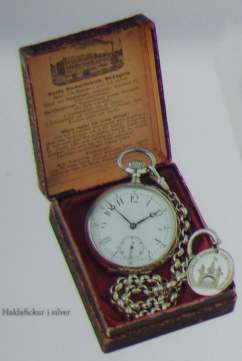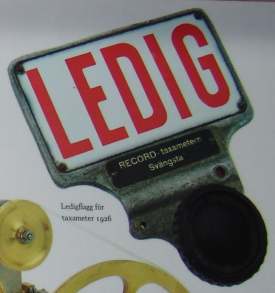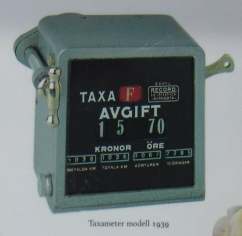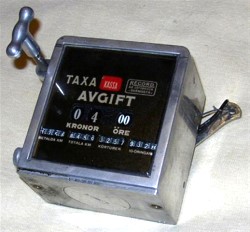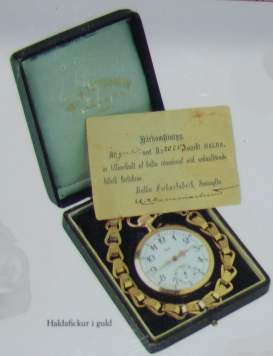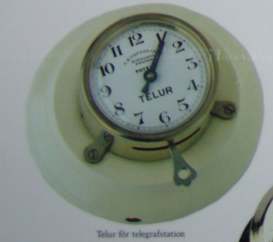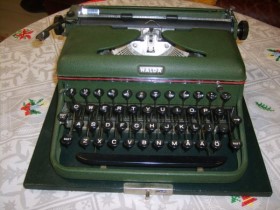Significant Years
| 1880
Henning Hammarlund visits Svängsta looking for a good location for his
future watch factory.
1891 Carl August Borgström is hired by Hammarlund as production manager and designer of taximeters.
1896 The first Halda taximeters were produced 1918 Halda runs into financial difficulties and Hammarlund leaves the company and Svängsta
|
. 1887 The first Halda pocket watches are produced at Svängsta.
1921 Carl August Borgström buys the watch production machinery and parts and starts AB Urfabriken. (ABU) 1926 AB Urfabriken presents its first taximeter under the name of Record
1934 Carl August Borgström dies and his son Göte becomes President of AB Urfabriken 1938 Göte Borgström designs his first taximeter.
1939 World War II starts and the market for taximeters vanishes.
|
1941 Göte Borgström presents his first four Record casting reel models to Swedish wholesalers.
In 1939 Göte Borgström had 25 examples of the A.B.Urfabriken Record 1500, 1600, 1700 and 1800 manufactured. These were put into a bag and he travelled to Gothenburg to meet the distributor Paul Berghaus. Berghaus liked what he saw, but did not want to have the name A.B.Urfabriken on the reels. Gote Borgström was in need of money, so he agreed on manufacturing them with the name Pebeco.
Berghaus ordered 3000 reels, got a promise about a further 2000 examples. The next customer who was scheduled, was Wilhelm Dönninghoff´s head of purchases. Borgström met head of purchases Torsten Persson at a hotel room in Gothenburg. Persson asked how many reels the A.B.Urfabriken could deliver. Borgström answered ‘about 15000 the first year and 25000 the following two years’. Persson suggested that Denninghoff´s should buy 10000 reels the first year and 15000 the following two years, with one condition, Denninghoff´s should have exclusive rights for the reels."
As A.B.Urfabriken needed that order to survive, Borgström agreed to the business deal."
A.B.Urfabriken was permitted to sell a very small edition without the brand mark W.D. This caused reels without W.D to be more unusual than with W.D, as was the Pebeco reel. Strangely enough often more is payed for a reel with the W.D label.
During the autumn of 1940 the first reels were delivered to Denninghoff´s and Pebeco. Both companies had big advertisement campaigns during the spring of 1941 for their reels. In 1941 the product line was increased with a cheaper reel, Record 1400."
All reels have a caramel-coloured handle (*Record 1800) and an uncoloured agate stone in the spool cap during their first years. Shades on the handle can vary, the Pebeco and W.D reels were given a darker shade. To give a difference to the different reel numbers, the handles got different colours. The 1600 a transparent green handle, the 1700 a white handle, the 1800 a transparent yellow handle. If the first 1800 ones were delivered with a caramel-coloured handle is still uncertain, but probable. In 1942 the product line was increased with Record 1550, 2000 and the fly reel Precision. All reels have MADE IN SWEDEN engraved on the handle side during the years 1939-1943. In autumn 1942-spring 1943 coloured agate stone were included on the reels, 1500 and 1550 got cheaper agate stones while the Record 2000 real ruby stone."
In 1943 the contract with Wilhelm Denninghoff´s expired. In 1943 the label MADE IN SWEDEN was moved to the reel foot. Model A was printed on the reels and a new, lighter spool was fitted.
Many thanks to Christian's Matevzic's above translation from the Swedish! (as well as the many others throughout this website!)
1949 Åke Murvall is hired as production manager and chief designer and the first spinning reel made by ABU is presented on the market.
1952 A revolutionary casting reel under the name of Ambassadeur is presented.
1954 Lennart Borgström starts at ABU and Göte and Lennart visit USA for the first time.
1955 The Borgströms import the first small mouth bass to Sweden.
1956 Garcia becomes the exclusive ABU distributor for the US.
1957 Abumatic, the first close-face reel made outside the US, is presented.
1959 ABU and Garcia badged Admiral reels were made by Everol (Italy) for a short time. These were red 4/0, 6/0, 7 1/2 /0 and urban legend say a 9/0 did exist.
1960 ABU 505, a completely new spinning reel without a bail is introduced.
1963 The first Japanese copies of the Ambassadeur show up.
1969 ABU acquires Haldex Taximeter Company in Halmstad.
1971 ABU buys the Addo-factory. (The Addo Company used to produce adding machines in that factory before the electronic revolution in that product area).
1974 Göte Borgström dies in May this year. ABU buys the Arjon Company.
1976 The majority of the ABU shares are sold to the Wallenberg Group’s Incentive AB.
1978 Garcia faces chapter 11 and Lennart Borgström moves to the US to try to save ABU’s most important market. At the end of that year ABU becomes the sole owner of Garcia, USA under the name of ABU Garcia, Inc.
1981 Lennart Borgström sells his remaining shares to Incentive and leaves the company to start his own business in the US.
1988 Incentive sells ABU Garcia to Aritmos (Another Swedish conglomerate).
1994 Aritmos sells ABU Garcia to Proventus (Again another Swedish conglomerate)
1995 Proventus sells ABU Garcia to Pure Fishing.
The images above were taken from A.B.Urfabriken's 75th Anniversary Poster.
